 By Yasmin Hashmi, KNXtoday
By Yasmin Hashmi, KNXtoday Light + Building 2018 was a real treat for the KNX professional. There was something for everyone and so much on show from KNX manufacturers, service providers and the KNX Association, that our show report has been split into several parts, some of which have been published this month. In this part, we will cover a selection of IoT, home automation, HVAC, water management, lighting and shading products and technologies.

The KNX IoT City was located in the Galleria of the Frankfurt Messe.
KNX IoT
The trade fair theme was ‘Connected-Secure-Convenient’, and KNX certainly lived up to this. A notable difference from L+B 2016 is how KNX IoT has developed. As one would expect, KNX Association provided a super overview of KNX IoT in the KNX IoT City. This showed how a KNX system
CAN be extended using wired and wireless local connections and integration with the cloud.
One of the key issues with IoT is semantics whereby devices can understand each other, and humans can understand what a device or service offers. KNX IoT will use the standardised JSON-LD linked data format to share semantic knowledge. Also in the KNX IoT City were Thread and Fairhair, the two industrial consortia with which KNX Association is partnering to define secure KNX IoT specifications (more on that in articles to follow).
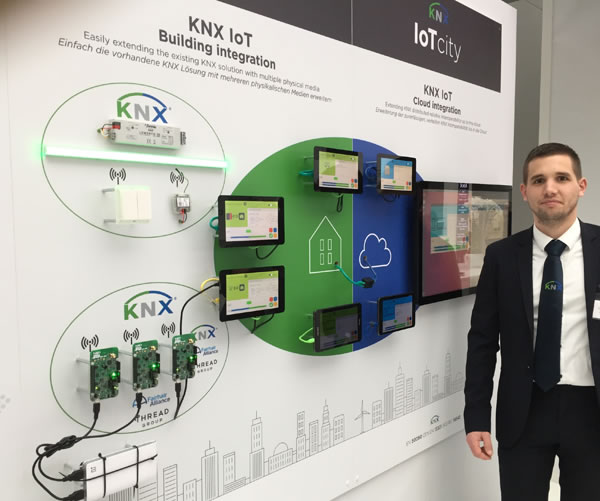
KNX Association KNX IoT Architect, Dries Verbrugge, explaining the principles of KNX IoT.
hager was showing combined solutions for the smart home using products from Hager and its
berker and Elcom brands. On show was the Domovea Easy server using the Hager ‘KNX easy’ commissioning software, designed for programming simpler systems such as single-family homes. It can be used with Hager actuators, Berker push button switches and Elcom door communication. Hager also offers IoT software to inte
RFace the system with
philips Hue lighting etc and to allow remote control via mobile devices, including messaging from door communications.
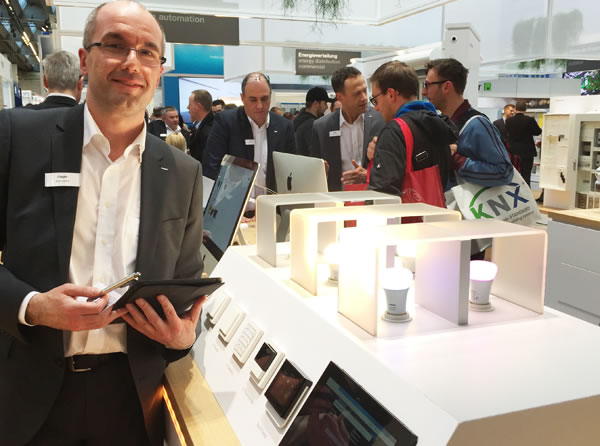
Hager’s Sven Lübeck demonstrating the Hager IoT software alongside the Philips Hue.
BAB Technologie was showing the BAB Appmodule which is designed to allow you to connect the IoT with KNX and
EnOcean using touch or voice control. It works with Amazon Alexa, Sonos, Philips hue, Netatmo, IFTTT, Apple HomeKit, Google Assistant, DoorBird and other smart home apps. The Appmodule also features integrated KNX router functionality and KNX project import. In addition, a brand new ‘Smart Screens’ app allows control of any IoT, KNX and EnOcean devices in one interface via smartphone.

Demo of the BAB voice control functionality and Smart Screens smartphone app (left) and the BAB Appmodule (right).
Schneider Electric announced the imminent launch of the Wiser family of products to allow wireless control of major residential applications via a smart device or voice control. Wiser includes an app and intelligent switches, dimmers, radio sensors, radiator thermostats and energy monitoring systems. A Wiser for KNX logic controller (formerly known as HomeLynk) is also available, providing a gateway between KNX,
Modbus,
BACnet and IP, and offering remote access and control of lights, blinds, heating, cooling, energy metering, a scheduler, an IP camera and new IoT applications.
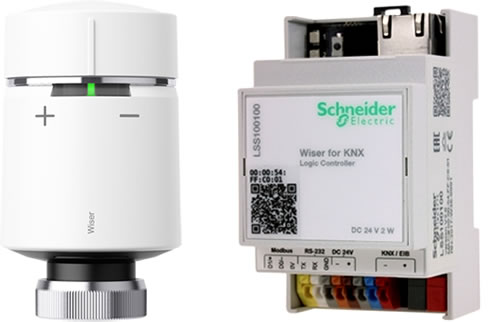
Schneider Electric Wiser Radiator Thermostat (left) and Wiser KNX Logic Controller (right).
In a separate announcement, Schneider said that it is collaborating with Somfy and Danfoss on a connecti
VITY ecosystem aimed at homes, mid-range buildings and hotels, that will work with KNX and other systems.
Home Automation
Gewiss was showing a complete home automation system based on its ‘Smart Gateway’. This provides a multi-protocol gateway between KNX,
ZigBee, Wi-Fi and LAN for full operability with Gewiss domotic solutions using the Microsoft Azure Cloud platform. Configuration of the system is done via the cloud using a drag and drop interface. A mobile and desktop app is provided for controlling functions such as lighting, roller shutters and venetian blinds, configuring and running scenes, adjusting the temperature and humidity in each room, monitoring energy consumption, managing the burglar alarm and technical alarms, viewing images from video cameras, and more.
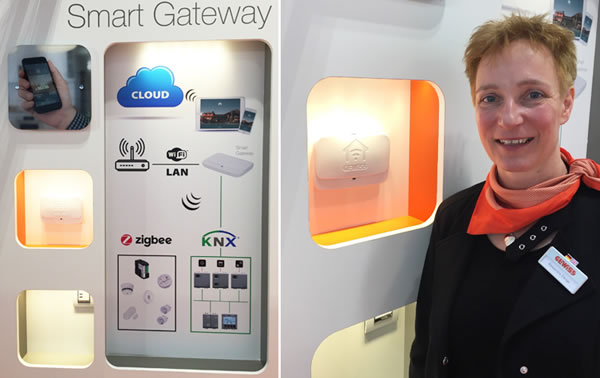
Alexandra Zange of Gewiss showing the company’s Smart Gateway system.
ComfortClick demonstrated its universal home automation platform with Amazon Alexa. The platform offers smart building visualisation, control and automation with the possibility of fully customising the user interface. It is designed to integrate and automate all systems and devices in any building via a range of different servers which currently support KNX,
Z-Wave, Amazon Alexa, ModBus, DSC alarm, IP cameras, Global Caché, IRTrans, Kodi (XBMC), Sonos, Philips Hue and IP intercom. Support for Google Home is next, with Apple HomeKit planned for the end of the year.

ComfortClick’s Flavio Sanches demonstrating ComfortClick software on the new ComfortClick Dozer Android 22″ wall panel, and holding the ComfortClick Jigsaw KNX server that includes a ComfortClick bOS Pro licence.
The E-Haus by the ZVEH (Central Association of German Electrical and Information Engineering Trades) is always a fascinating and inspiring exhibit at L+B. It comprises a mock-up of a residence that features the latest technologies for energy efficiency and management, comfort, security, and assisted living. This year it showcased a KNX IP and ModBus TCP network, lighting control using KNX, smart bathroom mirrors, connected domestic appliances and adjustable-height surfaces, car charging, smart TV, multiroom door communication and audio, control using touch and voice, smart metering, remote-controllable webcams, remote control of all systems, floors with sensors built-in, and much more.
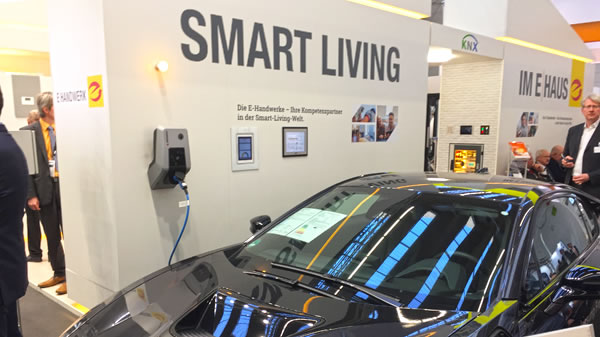
The ZVEH E-Haus featuring a KNX backbone.
HVAC
Whilst
theben was showing improved versions of its HMT-6 and HMT-12 heating actuators (see Mark Warburton’s show report
http://knxtoday.com/2018/04/1141 ... -building-2018.html),
ABB showed solutions for all areas of HVAC. The ABB ClimaECO includes three different KNX controllers and is designed to ensure that all functions in a room, such as lighting, sun-shading, heating and cooling systems are operated as efficiently as possible – resulting in HVAC efficiencies of up to 30%.
Based on the ABB
i-bus KNX system – where all devices communicate with one another via a single bus cable installed alongside the normal power lines, ClimaECO has an integrated BACnet interface that is automatically configured to integrate ClimaECO with established building management systems. Also on show were improved fancoil controllers, a room temperature controller (RTC), and the ABB Sentio with CO2 and humidity sensing.

(Left) The new ABB fancoil controller and room temperature controller and (right) ABB Sentio.
For window control, Geze was showing the Geze IQ box KNX. This KNX gateway enables communication between Geze IQ window drives and KNX pushbuttons and sensors for wind, rain, air-quality and humidity, that can be used to control the Geze window drives accordingly. At the same time, the IQ box KNX uses the intelligence of the window drives to report the mode of a window, or even its precise opening width, back to the KNX building system or BMS.

The Geze IQ box KNX gateway to Geze window drives and doors.
Water control
For water control, Franke demonstrated the Aqua 3000 Open water management system. This uses KNX to monitor water systems and automatically flush them if required, in order to prevent problems such as Legionnaire’s disease. The system can be individually programmed and can be expanded as required. Water quantities, water hygiene flushes, thermal disinfections and their temperature limit values can be individually set and monitored for each room and even for each individual fitting such as shower fittings, wash taps and flush valves. Malfunctions are detected immediately and reported.
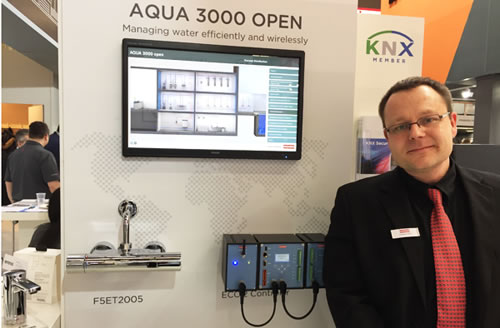
Franke’s Christian Witte explaining the principles behind the Aqua3000 open water management system.
Lighting
There were many
DALI-KNX gateways on show at L+B. Among these were new KNX multiprotocol gateways from Intesis. The IntesisBox DALI 2 gateway has more capacity and is available in five versions supporting up to 3000 points. This capability also holds true for the IntesisBox BACnet and ModBus gateways. The IntesisBox
M-Bus gateway for metering supports up to 120m of M-Bus, so additional hardware to power the bus is not required.
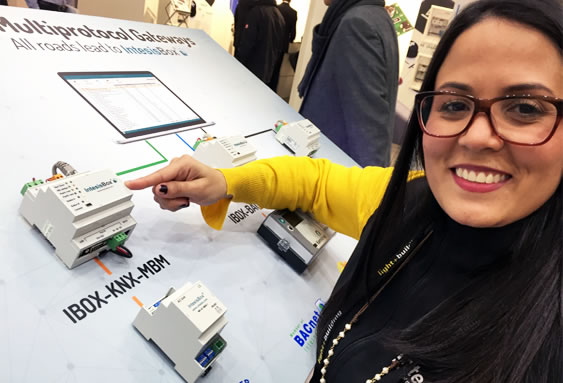
Intesis’ Maria Elena Cabello pointing out the IntesisBox ModBus to KNX gateway.
OEM to Schneider Electric, IPAS, is offering a firmware update for its DaliControl e64 KNX-DALI gateway. This now supports every type of DT-8 (DALI device type 8) for control of colour LEDs for tunable white, RGBW and x/y control. In addition to switch and dim functions, the DaliControl e64 can be used to control emergency lighting and to display the operating hours and lifespan of different lamps, as well as other applications. Also on show were two basic DALI gateways, namely the gc16-2 that as two DALI outputs to control 128 lamps, and the gc-16 that has one DALI output for control of 64 lamps. These too, support DT-8.
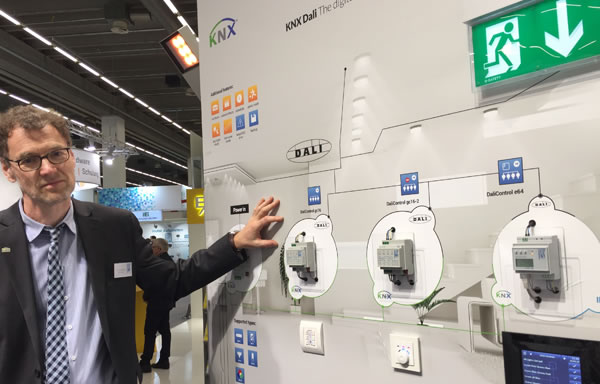
IPAS Managing Director Thomas Nierhoff showing applications of the DaliControl e64, the gc16-2 and the gc16 KNX-DALI gateways, all of which support DT-8.
Osram was showing the DALI Pro KNX, a KNX DALI gateway featuring a real time clock for daylight simulation. An app is available to control luminaires, scenes and effects, tunable white, daylight harvesting, presence detection etc. The unit can control up to 4 DALI channels with up to 64 addresses and 50 channels each.
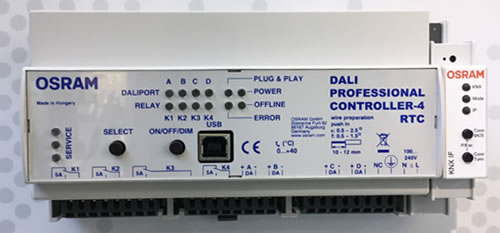
The Osram DALI Pro KNX gateway for lighting control.
Shading
For shading, Rademacher has just launched the Rollotube X-line of KNX tubular blind motors with built-in actuators, making them unique in terms of roller blinds. The motors are self-learning and available for roller shutters, awnings and venetian blinds. They include a number of useful positioning/length functions as well as blockage detection.

Rademacher Export and Sales Manager, Lisa Elsinghorst, demonstrating the Rollotube X-line of KNX motors with built-in actuator.
New on the Somfy stand was the KNX RTS Receiver WM. This provides a two-way communication bridge between a wireless Somfy remote and up to 18 Somfy RS484 motors via the wall-mounted wired RS485 Motor Controller WM.

Somfy’s Gabriele Carco demonstrating the KNX RTS Receiver WM with the RS485 Motor Controller WM.
Warema was showing surface-mounted sun shading actuators for 230V, 100V and 24V DC motors. These include manual override and remote programming via Bluetooth, which is useful if they are installed in false ceiling or suspended floors. The actuators have binary inputs for standard venetian blind pushbuttons and can also be remotely programmed for example, by using their serial number and the
SIEMENS ETS app.

Warema’s Sebastian Michler presenting the KNX SA 2M, 4M, 6M and 8M surface-mounted remotely-programmable actuators for shading control.
That concludes Part 1 of our show highlights covering IoT, Home Automation, HVAC and Water Management. If you have some of your own, please feel free to comment below. In
Part 2, we look at simpler design, installation and control. In Parts 3 and 4 next month, we will look at servers, gateways, switches, AV and security.
------------------------------------------------------
Highlights from Light + Building 2018 – Part 2: Simpler Design, Installation and Control
18/04/2018
 By Yasmin Hashmi, KNXtoday
By Yasmin Hashmi, KNXtoday If you were looking for tools to make KNX system planning, installation and operation easier, Light + Building 2018 had plenty to show. In Part 2 of our show highlights, we look at a selection of products and technologies that aim to make system planning, programming and operation easier.
Simpler planning and programming
In the KNX IoT City, a prototype of the KNX Smart Home Planner was being demonstrated. Designed to bridge the gap between users and professionals, it allows anyone to plan installations using a graphical user interface. It is assumed that it will be used for basic configurations, and that deep logic functions will be performed by a KNX professional. It offers features such as the creation of rooms and templates, the suggestion of suitable products for specified functions and the generation of buying lists. The project can then be exported to ETS for fine tuning.

Steven Klausnitzer of ISE, demonstrating a prototype of the KNX Smart Home Planner in the KNX IoT City.
Among the many offerings designed to make programming easier was iBEMI from Finnish manufacturer and KNX design services company, BEMI. This works with ETS Professional and a KNX system with an IP interface. It is aimed at fast visualisation programming for small projects using an iOS or Android smartphone. The iBEMI app allows the user to control lighting scenes, dimming, switching, air-conditioning, temperature, RGB, blinds, shutter control, energy indication with scale and offset, time and date, and a value transmitter. BEMI also offers the ‘KNX Tool’ drag and drop application for systems integrators to make function reports for selling projects.

BEMI Managing Director Michael Bendtsen showing the KNX Tools application.
Another planning tool that focuses on functions rather than products was on offer from ambiHome. With this, the installer can get a quote within 5 minutes. Once ordered, the programming of components will be done automatically, significantly reducing the costs of a typical project down to EUR4k, including components, programming and visualisation. The customer is given the ETS file including function and installation descriptions, and each component is individually labelled for installation.

AmbiHome’s Michael Becker and some examples of ambiHome-programmed and labelled components.
Simpler installation
Siemens’ answer to the age-old problem of fiddly connections is to provide a quick and easy installation technique for its KNX products. All you have to do is insert the wire and a connection is made.

Siemens Product Manager Ulrike Kull demonstrating the new connection technique on Siemens’ new universal KNX dimmer.
Lingg & Janke was again showing the KNX Quick entry-level system whereby electricians only require a screwdriver to program the system rather than ETS. In a separate move, the company has teamed up with Symcom to produce new visualisation for data produced by smart metering systems.
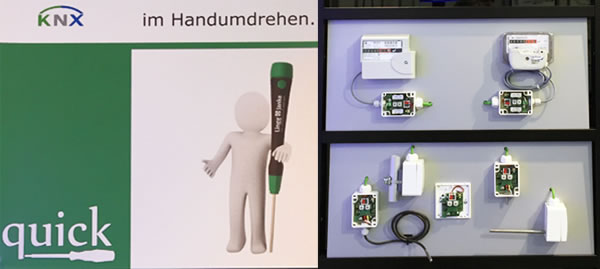
The Lingg & Janke KNX Quick system only requires a screwdriver to program KNX components.
A convenient invention for news builds, where KNX bus cable is expected to be installed alongside mains cable, is the Wieland Gesis NRG 7-pole flat cable. This accommodates three phases plus earth, as well as two poles for the KNX bus. The system is available with a basic KNX module plus a choice of six smart modules, requiring just one physical address for the whole system. Another advantage is that by having a distributed system like this requires less cable, and so reduces the fire risk.
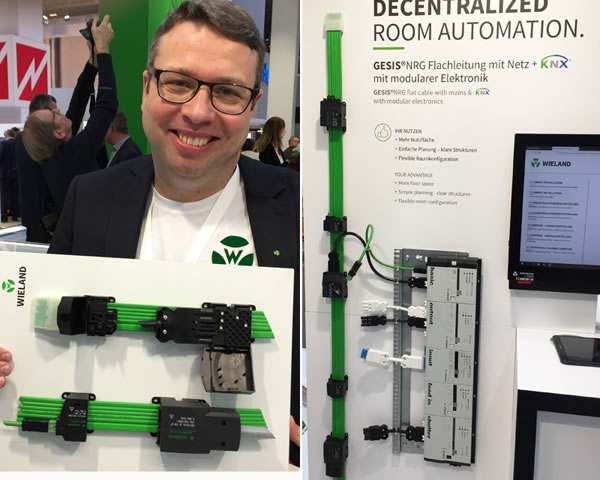
(Left) Wieland’s Ronny Gasser with the Wieland Gesis NRG flat cable sporting insulating-penetrating screw connections, and (right) the flat cable connected to the basic module and four smart modules.
KNX RF
For applications requiring wireless connections, there is a growing number of KNX RF products available. Elsner for example, was showing various KNX RF products including a media coupler that allows bus traffic to be monitored and devices to be reset, and new wireless actuators for one motor, two individual motors and one with a loop-through function. Also on show was the Remo KNX RF remote control that is a real remote control (and not a gateway). It supports 32 channels, can control scenes, shading etc, and can be used with wired products too.
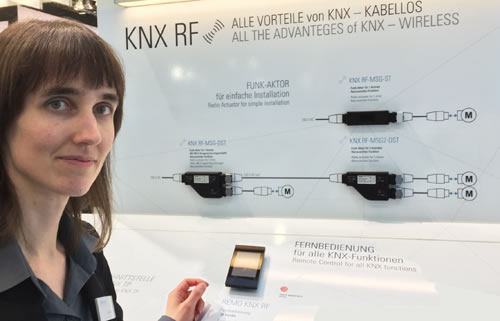
Elsner’s Rita Buse points out the new wireless actuators (top) and the Remo KNX RF remote control (bottom).
Dinuy, which also makes products for Müller (and vice versa), had a number of ‘Easy Mode’ KNX RF sensors and actuators for lighting, HVAC and blinds/shutters, along with an RF-to-TP media coupler. Prototype versions for use in System Mode were also on show, including four dimmers, LED, DALI and LED strips, 1-10V dimmers and a single-channel switch.

Prototype versions of the Dinuy Dinulink KNX RF ‘System Mode’ sensors and actuators.
Becker was showing a battery-powered radiator valve that uses KNX RF and a media coupler to bring the heating system into ETS. The company also offers the B-tronic home automation system that speaks KNX-RF natively and allows the integration of other products, such as the Hager smoke detector, or KNX sockets and switches, into the system.
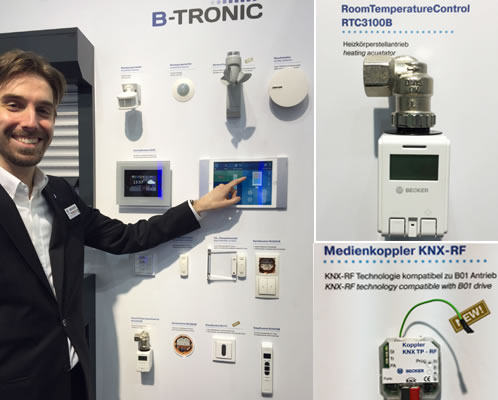
Head of the Becker Academy, Maik Wiegelmann, presents the Becker B-tronic KNX-RF- native control system and the KNX-RF RTC3110B radiator valve and KNX-RF media coupler.
Voice control
An unprecedented number of voice control of KNX systems or devices was demonstrated or previewed at L+B. The ABB Busch-VoiceControl KNX for example, was hailed as the first bridge to all three leading voice assistants, namely Amazon Echo, Google Home and Apple HomeKit, simultaneously. It enables users to control a range of KNX functions, including light switching and dimming, the operation of window blinds and thermostat settings, and to receive information about the current status of the building, including room temperature, light intensity and humidity. It will also detect any motion or occupancy within the property. The Busch-VoiceControl KNX can manage up to 99 functions and is fully configurable via the secure ABB MyBuildings portal.

The ABB Busch-VoiceControl KNX bridge to Amazon Echo, Google Home and Apple HomeKit.
Thinka was promoting its voice control system that currently supports Apple HomeKit and Amazon Alexa. The Thinka is typically installed on the DIN-rail, and connected to KNX via twisted pair, Ethernet and power. Thinka only needs to be connected to the Internet for updates, and communication between iOS devices and HomeKit-enabled accessories is encrypted. Control of accessories away from home is also supported using iCloud.
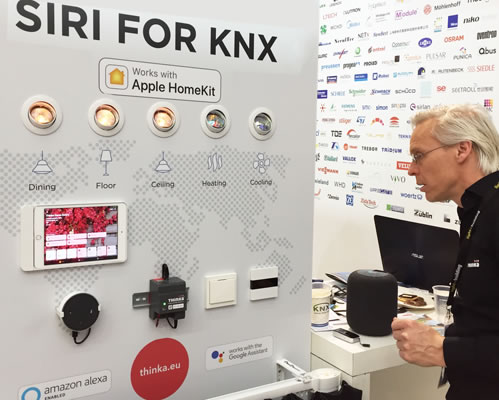
Thinka’s Alexander Ket demonstrating home control using voice commands through Apple’s Siri.
That concludes Part 2 of our show highlights covering simpler design, installation and control. If you have some of your own, please feel free to comment below. If you are interested in IoT, Home Automation, HVAC and Water Management, take a look at
Part 1.
In Parts 3 and 4 next month, we will look at servers, gateways, switches, AV and security.















































 提升卡
提升卡 置顶卡
置顶卡 沉默卡
沉默卡 喧嚣卡
喧嚣卡 变色卡
变色卡 千斤顶
千斤顶 显身卡
显身卡














